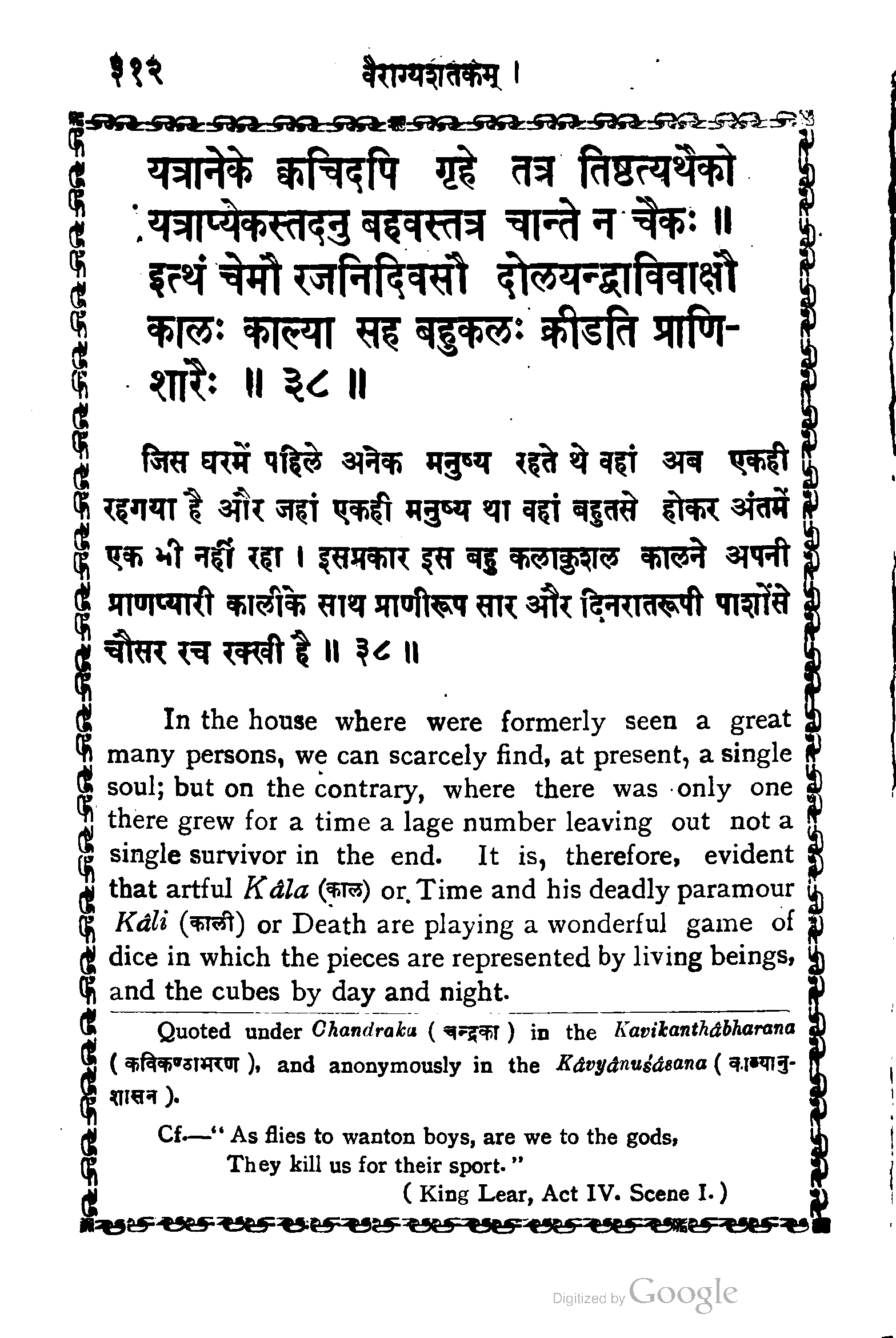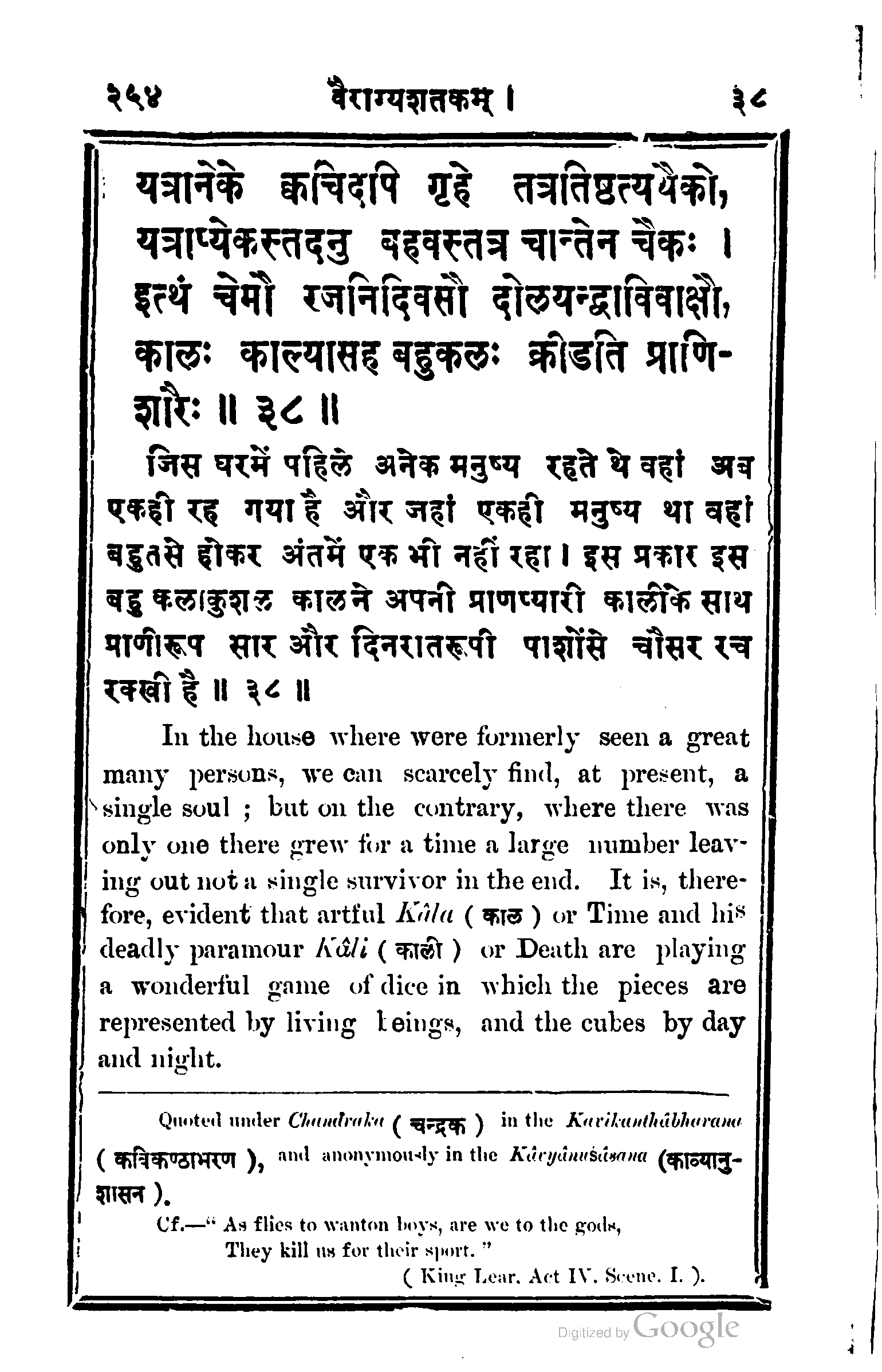Ryder
Brough
Tawney
Mādhavānanda
Telang
verse

Text (not proofread)
यत्रानेकः क्वचिदपि गृहे तत्र तिष्ठत्यसैको
यंत्राप्ये कस्तदनु बहवस्तत्र वान्ते न चैकः |
इत्थं चेमौ रजनिदिवसौ दोलयन्द्वाविषाक्षौ
कालः काल्या सह बहुकलः क्रीडति प्राणिसारैः ॥ ३ ९ ॥
footnote

Text (not proofread)
XXXIX . ( a ) ° कः ; का :. A. P. R. ( 6 ) चान्तेन चेक :; नैकोपि चान्त : A.
नैकोपि चान्ते . T. K. Bo . N. न कीपि चान्तै G. ( c ) चेमो ; नये . N. दो ° ; लो .
N. ° न्द्र / निवाक्षी ; ° न्त्राविवाशी . A. ° न विवाशी : ० ( १ ) . G. ० न्यापि वाक्षो . C. ( a )
काल्या ; कल्यैः . A. कव्यो . N. सह बहुकल :; भुवनफळके . T. K. Bo . ( Bo.n. हम्
for हे ) . G. N. सह बहुगळ :. A. ० णि ; ० ण . C. सा ° ; शा ० . N.
endnote


Text (not proofread)
St. XXXIX . - affel - for the gender see Siddh . Kaum . I. , 390 ,
कालः = वर्तमानादिः क्षणादिसमयो वा Rámarshi . But neither seems to be
very appropriate here . He also explains as Wi . e . Kâla's
a . The other commentator renders the two respectively by
and , for the latter of which I know of no authority
The two words seem to me here to signify the male
and female personifications of the Destructive Principle . Now F
is given by the Medinîkara as a name of Mahâkâla or Mahâdeva .
alt is well known to be a name of Pârvatî , Mahâdeva is the Deity
of Destruction , and is also represented in the Purânas as playing
with Pârvatî . and therefore may here be taken to mean
Siva and Párvati . बहु कल : - कन्ला is reudered by सुखदु : खदातृत्वादिकरण विशे
पाः and क्रीडा नैपुण्यम् by Ramarshi . सार = the pieces in a diceplay ; gene
rally written . The double meaning of Te ( as in Kadambarî p .
5 ) will be noticed . Compare Huxley's Lay Sermons p . 36 where a
similar figure is somewhat differently worked out . - Mandákrántá .
Kosambi
verse


Text (not proofread)
यत्रानेकः क्वचिदपि गृहे तत्र तिष्ठत्यथैको
यत्राप्येकस तदनु बहवस् तत्र चान्ते न चैकः |
इत्थं चेमौ रजनिदिवसौ दोलयन् द्वाविवाक्षौ
कालः काल्या सह बहुकलः क्रीडति प्राणिसारैः ॥ १७१ ॥
footnote


Text (not proofread)
171 Om . in GVS 2387 , probably on missing fol . in original . a ) A
H1c . 30 I यत्रानेके ; C D Eic Fi Hit . 2 यत्रानेकाः ; Est . st J1.3 यत्रानेका . Ts यत्र ( for
तत्र ) . F1 तिष्ठन्नथैको ; W 2-1 तिष्ठत्यनैको . – - 4 ) Y2 तेषु ( for तत्र ) . 12 चान्त्ये न चैकः ;
C चांतेपि चैक :; F1 जातेन चैक : ; F2 नैकोपि चांत :; F3.5 W Y1 . 2.4−4 T G2 . 3. ± t.v.5_M1 , 4 , 5
नकोपि चांते ; F½ ( first m.v. as in text ) नैकोस्मि ( second w.v. ° स्ति ) चांते ; X नैकोपि चास्ते ;
Ys चास्ते न चैक ; G1 चैकोपि चास्ते ; G4 नैको विभाति ; M2.3 चैकोपि चांते . - ● ) F3 J
Y1.2 . ± –4_T3G_M . नेयौ ; X : चोभौ ; T1 . 2 नेयै ( for चेमौ ) . J Y1 . 3 - 8 T ( G2-5 M1.5
लोलयद्वाविवाक्षौ ; G1 लोलयंत्राविविक्षौ ; M2 . 3 लोलयंत्राविवाक्षौ ; M + लोलयद्वाविवाओौ .
— ± ) I ) Y2 , 4–68 T ( G12t ± 5 M1 कल्यो ; Es F + ( m.v as in text ) Y3 ( 1203 कल्या ;
F2 . 3 कल्यैः ; Y1 काल्यो . [ G2.3com . कल्या - स्वपल्या ] . 8 ( except Gc 3c M2 - 5 )
भुवनफूलके ( Gat कैः Q ) ( for सह बहुकल : ) . W2t . 3. + क्रीडते . A1 ( torig . ) , 2.3 E2 I Js
प्राणसारैः ; B1 प्राणशीरैः ; B2CW X Y1 . 2.4-0.8 T1.2 G2-6 M1 . 1 प्राणिशारैः ; Eot M3 . 5
प्राणिसारे ; YT प्राणिजालैः ; T3 प्रा * शांतैः ; G1 M2 प्राणिनाशै : .
BIS . 5077 ( 2294 ) Bhartṛ . ed . Bohl . 3. 43. Haeb . and Galan 39. lith . ed . I. 40 .
II . 38 ; ŚRB . p . 374. 199 ; SKM . 131.54 ( Candraka ) ; SRH . 35.50 ( Bh . ) ; SRK . P.
100. 3 ( Bh . ) ; Kāvyānuśāsana of Vaghhata 1 ( KM . 46 , p . 6 ) ; Kavikanthābharana
4 ( KM . 4 , p . 137 , Candraka ) ; SN . 811 ; SSD . 4. f . 5b .

